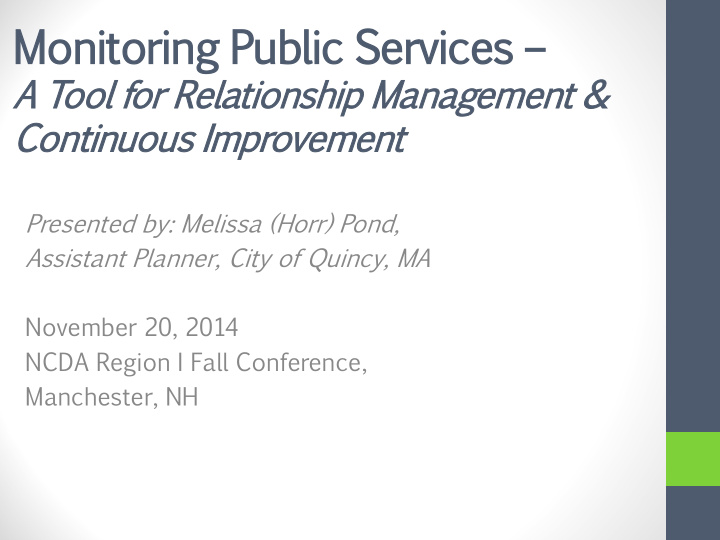



Monit nitoring ing Public ic Ser ervic ices es – A Tool f for R Rela lationship M Management & & Cont ntinu nuous I Improvement nt Presented by: Melissa (Horr) Pond, Assistant Planner, City of Quincy, MA November 20, 2014 NCDA Region I Fall Conference, Manchester, NH
Steps to Successful Monitoring: • Provide Prep Guide • Send Adequate Communications • Focus on Reporting Sections • Perform Desk Audit Prior to Visit • Conduct Site-Visit Interview & Documentation Request
Monitoring Prep Guide – For Review & Reflection 1. Technical Assistance a. Workshops/Events to build capacity through skill-building, networking, & collaborating b. Prepare subrecipient to reflect on past events & think forward 2. Performance Measurement a. Based on HUD’s 2003 requirement to develop “Performance Measurement System” b. Prepare subrecipient to reflect on stated performance measurement system (provided in RFP/contract) & think forward
Monitoring Prep Guide – Documentation • Note: Depth of documentation review depends on the size and capacity of the organization; therefore, not all documentation may be required. • “In using Federal funds the cardinal rule is: documentation... If your activities, personnel, expenditures, and results are not documented properly, from the Federal Government’s perspective, you have not done your job, regardless of your accomplishments.” - Playing by the Rules Handbook
Monitoring Prep Guide – Documentation Financial Management (Playing by the Rules , Ch 2): • Internal Controls: Org Chart; Definition of duties; Accounting procedures • Accounting Records: chart of accounts; general ledger; cash receipts journal; cash disbursements journal; etc. • Allowable Costs: Clearly defined set of standards and procedures; approved indirect cost allocation plan • Source Documentation: time sheets, cancelled checks, invoices, receipts, etc • Budget Controls: Approved budget for all funded activities • Cash Management: Procedure for accurately projecting cash needs of the organization • Financial Reporting: Most recent Independent Public Accountant (IPA) audit • Procurement and Contracting (Ch 3): • Written procurement manual • Purchasing Documents: purchase orders, contracts, delivery receipts, invoices, etc. • Property Management (Ch 4): • Inventory Report of Non-expendable Personal Property valued at $300+ which must include: property • description; identification; funding source grant number; title holder; acquisition date and cost; federal share of cost; location, use and condition; unit acquisition cost; disposition data Record-Keeping and Reporting Requirements (Ch 5): • Legal Files: articles of incorporation, bylaws of the organization, list of board members (for the monitoring • period), tax status, board minutes (for the monitoring period), contracts and other agreements, (and annual reports to the secretary of the state) General program files: files relating to subrecipient’s application to the grantee, Subrecipient agreement, • program policies and guidelines, correspondence with grantee and reports, draw down requests; progress reports; technical assistance and training files; resumes and job descriptions of chief admin / chief fiscal officers and key program personnel Project/case files: beneficiary information; schedule of direct service programs •
Monitoring Prep Guide – Resource Guide Code of Federal Regulations (http://www.ecfr.gov/) Title 24: Housing & Urban Development Part 84 – Uniform admin requirements for grants and agreements with institutions of higher ed, hospitals, & npos Part 85 – Admin requirements for grants & cooperative agreements to state, local, & federally recognized Indian Tribal Governments Part 570 – Community Development Block Grants Office of Management and Budget (OMB) Circulars (http://www.whitehouse.gov/omb/circulars_default/) A-87 “Cost Principals for State & Local Governments” A-122 “Cost Principals for Non-profit organizations” A-133 “Audits of States, Local Governments, & Non-profit organizations” Playing By the Rules: A Handbook for CDBG Subrecipients on Administrative Systems” HUD 2005 ( http://portal.hud.gov/hudportal/documents/huddoc?id=DOC_17104.pdf)
Adequate Communications
Reporting Sections I. I. STANDA DARD (In ( Introduction: S State Wh Why, Wh What, Wh When, Wh Who, H How) a. Reference 24 CFR 85.40 of Title 1 of Housing & Community Development Act of 1974 as the WHY b. What fiscal years? Who are you and Who are you meeting with? What organization? What program? II. II. SUBR BRECIP CIPIENT M MANAGE GEMENT a. Sub recipient Agreements b. Sub recipient Training & Technical Assistance Workshops/Events c. Board of Directors d. Annual Reports to the Office of the Secretary of State & Tax Compliance Non-Profit Status III. III. ELIGIBL IGIBLE ACTIVIT CTIVITIE IES & & ME MEETING LMI NATI TION ONAL OBJ OBJECTIV CTIVE a. Eligible Activities and Public Service Programs b. Meeting and documenting the Low/Moderate National Objective
Reporting Sections IV. PR IV. PROPO POSED AND A ND ACTUAL OUTPU O PUTS YEAR Proposed Actual Actual vs. Low/Mod % Low-Mod ENDING Unduplicated Unduplicated Proposed Count Count Count (CAPER) (Contract) (CAPER) June 30, 9 10 111% 10 100% 2012 June 30, 7 11 157% 11 100% 2013 June 30, 8 8 100% 8 100% 2014 V. V. PERFORMANCE MEASU ME SUREME MENT SY SYST STEM VI. VI. FINA NANC NCIAL MANA M NAGEMENT NT a. CDBG Budget, Expenditures, & Invoicing b. Cover Letter of Third Party Audit c. Program Income d. Procurement and Inventory Reports e. Leveraging Resources
Interview Questions: Technical Assistance & Performance Measurement 1. Which workshops/events were attended and what were your take-a- ways or thoughts towards improvement based on the attended workshops? 2. What are some of the needs of your organization that training and technical assistance may assist? What are some of the needs of your clients where staff of your organization needs some training to better provide for those needs? Do you have any other requests of the PCD for workshops and/or events for the future? 3. Reflecting on current performance measurement system, are there other indicators that could more clearly define success for your program?
Summa mmary ry: Use the monitoring as a tool for continuous improvement and relationship management by not playing “gotcha”; but rather, open the lines of communication by being clear about documentation needs, performance measurement, and technical assistance opportunities. Con ontact act: Melissa (Horr) Pond, Assistant Planner, City of Quincy, MA mhorr@quincyma.gov 617-376-1053
Recommend
More recommend